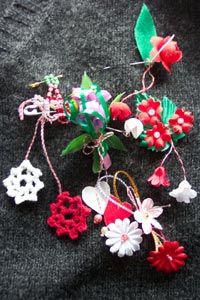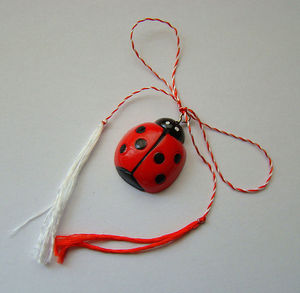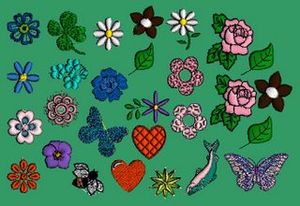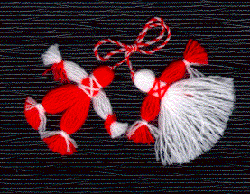Happy Martisor!
Dear Everyone,
 I just wrote a whole great long post about Martisor and what a lovely festival it is in Roumania, followed by the story of it, another few myths and legends and then something happened and I lost the lot. Daaaaamn computer! Here I go all over again.
I just wrote a whole great long post about Martisor and what a lovely festival it is in Roumania, followed by the story of it, another few myths and legends and then something happened and I lost the lot. Daaaaamn computer! Here I go all over again.
So, very quickly, and before I lose my rag, here are some myths for the existence of Martisor (from the word for the month of March - Martie, and then the suffix meaning little or dear...as we call Rutzi "Rutzisor", or Flori "Florisor", the 's' being pronounced 'sh'), why we exchange the adorable charms and pins on red and white string or ribbons on 1st March and what it means for eastern Europeans, particularly Roumanians as I don't know about the others. It really is a very pretty festival and makes me yearn for Roumania even a little more than usual:
According to one of the several proposed legends attempting to explain the Mărţişor/Martenitsa in Bulgaria, the custom has roots in the late seventh century. This legend, first attested in the 20th century, says that the Bolgar Khan Asparukh wanted to send a message to other Bolgars across the Danube. He tied his letter with a white string to the leg of a white pigeon. The Eastern Romans (i.e. Proto-Romanians) saw the pigeon flying and wounded it with an arrow. It was finally able to deliver the important message but the white string had turned red with the pigeon's blood. The Bulgars then started to wear this thread.
attempting to explain the Mărţişor/Martenitsa in Bulgaria, the custom has roots in the late seventh century. This legend, first attested in the 20th century, says that the Bolgar Khan Asparukh wanted to send a message to other Bolgars across the Danube. He tied his letter with a white string to the leg of a white pigeon. The Eastern Romans (i.e. Proto-Romanians) saw the pigeon flying and wounded it with an arrow. It was finally able to deliver the important message but the white string had turned red with the pigeon's blood. The Bulgars then started to wear this thread.
 Another Bulgarian "alternative theory" completely omits the role of the Bulgars in introducing the Martenitsa into the Balkan folklore, and instead links the custom to the Thracians (but excludes the Romanised Thracians/Romanians altogether).
Another Bulgarian "alternative theory" completely omits the role of the Bulgars in introducing the Martenitsa into the Balkan folklore, and instead links the custom to the Thracians (but excludes the Romanised Thracians/Romanians altogether).
Pic on left is my most beloved Martisor, a 70 year old gold piggy called Horatio, from whom I shall never be parted.
Here's another legend: On the first day of March, Spring came out to the verge of the forest. She looked around and saw in the blackthorn a little dainty snowdrop struggling up from the snow. Kind Spring wanted to help the snowdrop and started to take away the snow and thorny branches. Winter saw this and became angry. She brought severe winds and more snow to wipe out the little flower. However Spring covered it with her hands where it began to wilt. She cut her finger and hot blood dropped onto the little flower, reviving it. Thus Spring won over Winter. Since that time people wear little martisors which symbolise red blood on white snow.
around and saw in the blackthorn a little dainty snowdrop struggling up from the snow. Kind Spring wanted to help the snowdrop and started to take away the snow and thorny branches. Winter saw this and became angry. She brought severe winds and more snow to wipe out the little flower. However Spring covered it with her hands where it began to wilt. She cut her finger and hot blood dropped onto the little flower, reviving it. Thus Spring won over Winter. Since that time people wear little martisors which symbolise red blood on white snow.
And there's more. This is the most common of Martisor raisons d'être: There was a time when the Sun used to take the shape of a young man and descend on Earth to dance among folk people. A dragon found out about this and followed the Sun on Earth, captured him and confined him to a dungeon in his castle. Suddenly the birds stopped singing and the children could not laugh anymore but no one dared to confront the dragon.
One day a brave young man set out to find the dungeon and free the Sun. Many people joined in and gave him strength and courage to challenge the mighty dragon. The  journey lasted three seasons: summer, autumn and winter. At the end of the third season the brave young man finally reached the castle of the dragon where the Sun was imprisoned. The fight lasted several days until the dragon was defeated. Weakened by his wounds the brave young man however managed to set the Sun free to the joy of those who had believed in him. Nature was alive once again, people smiled once more but the brave young man could not make it through spring. His blood continued to drain from his wounds into the snow. With the snow melting, white flowers called snowdrops, harbingers of spring, sprouted from the thawing soil. When the last drop of the brave young man's blood fell on the pure white snow he died with pride that his life had served a noble purpose.
journey lasted three seasons: summer, autumn and winter. At the end of the third season the brave young man finally reached the castle of the dragon where the Sun was imprisoned. The fight lasted several days until the dragon was defeated. Weakened by his wounds the brave young man however managed to set the Sun free to the joy of those who had believed in him. Nature was alive once again, people smiled once more but the brave young man could not make it through spring. His blood continued to drain from his wounds into the snow. With the snow melting, white flowers called snowdrops, harbingers of spring, sprouted from the thawing soil. When the last drop of the brave young man's blood fell on the pure white snow he died with pride that his life had served a noble purpose.
Since then, people braid two tassles, one white and one red, with a charm often attached. Told you that already, but just a reminder. Every March 1, men offer this amulet called Martisor to their loved ones. Women offer Martisor amongst themselves bringing luck and good health. The red symbolises love for all that is beautiful and also the blood of the brave young man, while white represents purity, good health and the snowdrop, the first flower of spring. And snow. And lemon sorbet. No, it doesn't. Just kidding. In the country, they hang Martisor on fruit trees for a good yield, or on doors for the good health of those within.
men offer this amulet called Martisor to their loved ones. Women offer Martisor amongst themselves bringing luck and good health. The red symbolises love for all that is beautiful and also the blood of the brave young man, while white represents purity, good health and the snowdrop, the first flower of spring. And snow. And lemon sorbet. No, it doesn't. Just kidding. In the country, they hang Martisor on fruit trees for a good yield, or on doors for the good health of those within.
I do wish though, that there were Roumanian legends that didn't always have to end with good people making massive (and often ridiculous) sacrifices to save beauty or nature. Nicole and I were only talking about Manole and his wife Ana the other day, the latter ending up immured in the monastery of Curtea Arges in the XV, because Manole dreamed that giving his wife's beauty to the grounds and foundations of the church was the only way to make it solid and stop it falling down every night once sun had set. The church of Curtea Arges apparently has the beauty of Ana in its soul. And its not the only one. Many beautiful monuments and monasteries are rumoured to have swallowed up a life or two in order to be constructed/erected/created/remain standing.... It depicts Roumanian mentality perfectly. That from anything beautiful comes immense sacrifice and that you can't have a single good thing in life unless you suffer terribly for it beforehand... tara de inima mea.... One loses yet again and...asta e. A shrug of the shoulders. Just get on with it. It's normal.
Happy Martisor!
Sanatate! Bucurie! Noroc!

/https%3A%2F%2Fstorage.canalblog.com%2F33%2F16%2F508287%2F95344135_o.jpg)
/https%3A%2F%2Fstorage.canalblog.com%2F52%2F26%2F508287%2F95342137_o.jpg)
/https%3A%2F%2Fstorage.canalblog.com%2F42%2F99%2F508287%2F95342518_o.jpg)
/https%3A%2F%2Fstorage.canalblog.com%2F97%2F52%2F508287%2F55786848_o.jpg)
/https%3A%2F%2Fstorage.canalblog.com%2F33%2F68%2F508287%2F55786597_o.jpg)
/https%3A%2F%2Fstorage.canalblog.com%2F40%2F91%2F508287%2F98712362_o.jpg)
/https%3A%2F%2Fstorage.canalblog.com%2F38%2F76%2F508287%2F83379594_o.jpg)
/https%3A%2F%2Fstorage.canalblog.com%2F06%2F96%2F508287%2F83377251_o.jpg)
/https%3A%2F%2Fstorage.canalblog.com%2F92%2F69%2F508287%2F69301410_o.jpg)